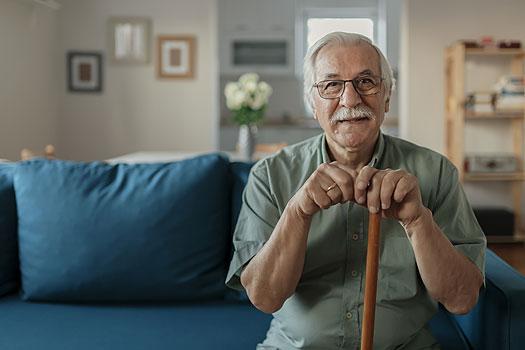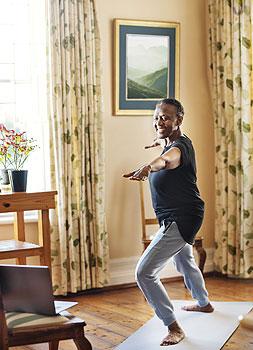“I Can’t Exercise Because…”

Overcoming barriers to being physically active
The American Geriatrics Society (AGS) recently evaluated the relationship between activity level and frailty—which is the medical term for weakness and disability. “Becoming frail as we age increases our risk for poor health, falls, disability and other serious concerns,” the AGS experts said. But, they noted, “people over 70 who were physically active on a regular basis, as well as people who increased their level of activity to a regular basis, were able to improve or maintain their level of frailty—not only physically, but also psychologically and socially.”
If you are an older adult, it’s important to examine any perceived impediments to being physically active that you might have:
“I’m living with a disability.”
As we grow older, we’re likely to be dealing with health challenges such as arthritis, osteoporosis, visual impairment, stroke or dementia. Previous generations of older adults were advised to “take it easy” and spend their days in the rocking chair. But now, experts know that’s actually the worst thing we can do! With rare exceptions, every older adult can benefit from a program of appropriately modified activities. Ask your doctor to recommend an activity plan that’s right for you. Being active can not only help you manage your existing health challenges, but also can help to prevent new ones! If you’ve been inactive, seek expert guidance as you ease back into a more active life.
“I’m afraid I’ll fall.”
No doubt about it, falls are a major health threat for older adults, causing loss of independence and even life for many seniors each year. Again, the old wisdom was that seniors should remain sedentary for their own safety. But in fact, this was very bad advice! Inactivity quickly leads to a loss of strength, and that is a top risk factor for another fall. The key is to exercise safely, building strength, endurance and flexibility. And did you know that certain exercises can improve our sense of balance? Ask your doctor about a fall prevention class.
 “I’m keeping myself safe during the pandemic.”
“I’m keeping myself safe during the pandemic.”
One year ago, as we moved into quarantine, many of us found our usual exercise routines seriously interrupted. Gyms closed, exercise classes through senior centers and senior living communities were suspended, and it was no longer deemed safe to go on a group walk. Fortunately, many senior-supporting organizations have really stepped up to the plate at this time. There are online fitness classes and videos, and socially distanced outdoor activities. If you live in a senior living community, talk to staff about what’s available. Protecting yourself from COVID-19 is a very important goal at this time—but so is protecting your health with exercise.
“I don’t have time!”
Many older adults these days are finding themselves with too much time on their hands. Spend some of that time working out for a real health and mood boost! Or, maybe you are still working, or helping care for grandchildren, or you’re a family caregiver for your spouse or other loved one. Make exercise a priority at this time. Get it on your calendar! And did you know that our electronic devices might also be creating a time deficit? Statistics show that older adults in the U.S. are spending increased hours sitting in front of the TV, or staring at a computer or smartphone. Replace some of that screen time with exercise.
“I get bored!”
“They don’t call it an exercise ‘routine’ for nothing,” you might be thinking. It’s true that after a while, any activity can feel repetitive. Mix it up! Work out to an exercise video several days a week. Go for a socially distanced walk if that’s safe. Take advantage of offerings at your senior living community. Multitask with an online exercise class—studies show they offer a good dose of socialization. If you’re able, walk on a treadmill while watching TV or listening to music. Doing chores or gardening also provide beneficial exercise.
“I’ll never live up to the fitness guidelines—so why bother?”
You’ve probably read the advice to get 150 minutes per week of moderate-intensity exercise, or to take 10,000 steps per day. Older adults shouldn’t feel intimidated by those recommendations. Experts say half that number of steps is probably a reasonable goal—and the National Institutes of Health recently noted that the intensity of those steps doesn’t matter. Taking our time and walking at a more leisurely pace as we accrue those steps is just fine—with a goal of adding a little more exercise as we progress. “People think they have to start going to the gym and exercising hard to get fitter,” said Dr. Elin Ekblom-Bak, of the Swedish School of Sport and Health Sciences. “But it doesn’t have to be that complicated. For most people, just being more active in daily life is enough to benefit health, since levels are so low to start with. The more you do, the better.”
“Sometimes I just don’t feel like moving around.”
The word “sedentary” actually means “sitting”—and in October 2020, experts from University of California, San Diego noted that even if we’re not moving much, standing can improve our health and even lengthen our life. “Standing is a feasible approach to interrupt long periods of time sitting that take place throughout the day,” said study author John Bellettiere, Ph.D. “We find this most beneficial for older adults who may not be able to partake in moderate-to-vigorous activities anymore, but can still follow a healthy aging lifestyle safely just by replacing sitting with standing up more.” So, stand up while you’re watching TV—perhaps every time a commercial comes on. Fashion a standing desk with your laptop on the kitchen counter. Stand up to talk on the phone, or while you’re looking out the window. Every little bit truly does help!
Source: IlluminAge Communication Partners; copyright 2021 IlluminAge
![Grace Barker Health [logo]](https://www.gracebarkerhealth.com/wp-content/themes/gracebarker-2017/images/logo.png)




